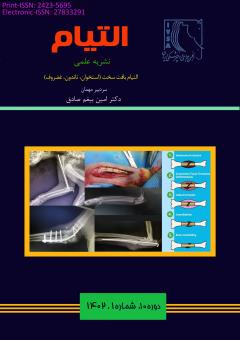غضروف و ترمیم غضروف در سگ ها و گربه ها
محورهای موضوعی : علوم جراحی دامپزشکی شامل جراحی های بافت های سخت و نرم
1 - دانشجو، گروه علوم درمانگاهی، دانشکده دامپزشکی، دانشگاه شیراز، شیراز، ایران
کلید واژه: غضروف, غضروف مفصلی, پیوند غضروف,
چکیده مقاله :
بافت غضروف به عنوان بافت ضربه گیر و تسهیل کننده حرکت استخوان و مفاصل بدن نقش دارد؛ به همین دلیل آسیب بافت غضروفی میتواند عملکرد طبیعی و مناسب اندام را تحت تاثیر قرار دهد. غضروف بر اساس نوع رشتههای موجود در بافتزمینهای و همینطور درصد ترکیب آنها، به انواع مختلفی تقسیم میشود که هرکدام ویژگیهای عملکردی متفاوتی دارند. غضروف شفاف معمولترین و فراوانترین نوع غضروف است که سرشار از کلاژن نوع ΙΙ و پروتئوگلیکان میباشد. غضروف الاستیک که به آن غضروف زرد نیز گفته میشود، از انعطافپذیری و اتساعپذیری بیشتری برخوردار است. در ساختار ماتریکس این غضروف، علاوه بر رشتههای کلاژن نوع ΙΙ، مقدار زیادی رشتههای الاستیک نیز حضور دارند. در واقع حضور همین رشتههای الاستیک، عامل توانایی این نوع غضروف در تغییر شکل و بازگشت به حالت اولیه میباشد. غضروف فیبری که غضروف سفید نیز مینامند، سختترین نوع غضروف میباشد. ویژگی بارز این نوع غضروف، تحمل وزن بالا میباشد. غضروف فیبری حاوی رشتههای کلاژن ریزی است که در بین لایههای ماتریکس پراکنده شدهاند، اما بین دستههای کلاژن فاصله وجود دارد. قدرت ترمیمی بافت غضروفی بسیار محدود بوده و ترمیم این بافت پس از آسیب، همواره با چالش ها و مشکلاتی همراه می باشد. آسیب غضروف مفصلی به عنوان یکی از مهمترین چالش های جراحان ارتوپد مطرح می باشد و همچنان تلاش برای یافتن راه مناسب برای ترمیم حداکثری این بافت، ادامه دارد. امروزه روش های مختلفی برای درمان آسیب غضروف مفصلی بکار گرفته می شود اما در هیچکدام از روش ها ترمیم کامل و بازگشت تمامیت بافتی غضروف مفصلی حاصل نمیگردد. روش های جراحی به دو دسته، ترمیمی و بازسازی تقسیم می شوند. در روش های ترمیمی، بدن تحریک می شود تا در ناحیه ضایعه، بافت ترمیمی جایگزین بسازد. اما در روش های بازسازی، با کمک گرفتن از پیوندهای مختلف، محل ضایعه با بافت غضروفی بازسازی می شود. هدف از این مقاله، مروری بر ساختار غضروف و روش های ترمیم غضروف مفصلی می باشد.
Cartilage is a strong, flexible connective tissue that protects joints and bones. It acts as a shock absorber throughout body. Cartilage is divided into different types based on the type of fibers in the underlying tissue as well as the percentage of their composition, each has different functional characteristics. Hyaline cartilage is the most common and abundant type of cartilage rich in type ΙΙ of collagen fibers and proteoglycan. Elastic cartilage has more flexibility and in the matrix of this cartilage, in addition to the type ΙΙ of collagen fibers, a large amount of elastic fibers is also present. In fact, the presence of these elastic fibers is a factor in the ability of this type of cartilage to change shape and return to its original state. The fibrocartilage is the strongest type of cartilage. The characteristic feature of this type of cartilage is high weight bearing. Fibrocartilage contains collagen fibers scattered between layers of the matrix. The restorative strength of cartilage tissue is very limited and the repair of this tissue after injury is always accompanied by challenges and problems. Articular cartilage damage is considered as one of the most important challenges of orthopedic surgeons. Today, different methods are used to treat the articular cartilage defect, however, in none of the methods complete restoration and restoration of tissue integrity of articular cartilage is achieved. Surgical procedures are divided into two categories, reparative and restorative surgery. The purpose of this article is to review the structure of cartilage and the methods of articular cartilage healing.
1. Baumann CA, Hinckel BB, Bozynski CC, Farr J. Articular cartilage: Structure and restoration. Joint preservation of the knee: A clinical casebook. 2019:3-24
. 2. Mainil-Varlet P, Aigner T, Brittberg M, Bullough P, Hollander A, Hunziker E, et al. Histological assessment of cartilage repair: a report by the Histology Endpoint Committee of the International Cartilage Repair Society (ICRS). JBJS. 2003;85(suppl_2):45-57
. 3. McNickle AG, Provencher MT, Cole BJ. Overview of existing cartilage repair technology. Sports medicine and arthroscopy review. 2008;16(4):196-201
. 4. Hunziker EB. Articular cartilage repair: basic science and clinical progress. A review of the current status and prospects. Osteoarthritis and cartilage. 2002;10(6):432-63
. 5. Borrelli Jr J, Olson SA, Godbout C, Schemitsch EH, Stannard JP, Giannoudis PV. Understanding articular cartilage injury and potential treatments. Journal of orthopaedic trauma. 2019;33:S6-S12
. 6. Newman AP. Articular cartilage repair. The American journal of sports medicine. 1998;26(2):309-24
. 7. Sulaiman SZS, Tan WM, Radzi R, Shafie INF, Ajat M, Mansor R, et al. Comparison of bone and articular cartilage changes in osteoarthritis: a micro-computed tomography and histological study of surgically and chemically induced osteoarthritic rabbit models. Journal of Orthopaedic Surgery and Research. 2021;16:1-13
. 8. Krych AJ, Saris DB, Stuart MJ, Hacken B. Cartilage injury in the knee: assessment and treatment options. JAAOS-Journal of the American Academy of Orthopaedic Surgeons. 2020;28(22):914-22
. 9. Zhou Q, Cai Y, Jiang Y, Lin X. Exosomes in osteoarthritis and cartilage injury: advanced development and potential therapeutic strategies. International journal of biological sciences. 2020;16(11):1811
. 10. Chahla J, Stone J, Mandelbaum BR. How to manage cartilage injuries? Arthroscopy. 2019;35(10):2771-3
. 11. Caplan AI, Elyaderani M, Mochizuki Y, Wakitani S, Goldberg VM. Overview: Principles of cartilage repair and regeneration. Clinical Orthopaedics and Related Research®. 1997;342:254
. 12. Liu Y, Shah KM, Luo J. Strategies for articular cartilage repair and regeneration. Frontiers in Bioengineering and Biotechnology. 2021;9:770655
. 13. Ao Y, Li Z, You Q, Zhang C, Yang L, Duan X. The use of particulated juvenile allograft cartilage for the repair of porcine articular cartilage defects. The American journal of sports medicine. 2019;47(10):2308-15
. 14. Yoon K-H, Park J-Y, Lee J-Y, Lee E, Lee J, Kim S-G. Costal chondrocyte–derived pellet-type autologous chondrocyte implantation for treatment of articular cartilage defect. The American Journal of Sports Medicine. 2020;48(5):1236-45
.


